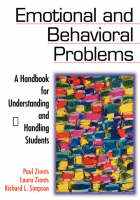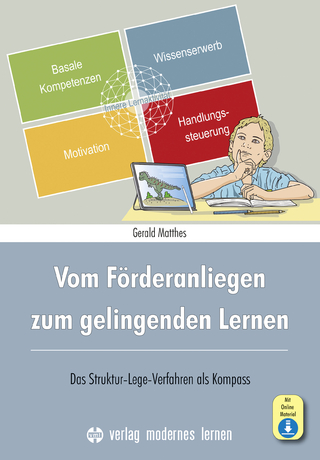
Emotional and Behavioral Problems
Corwin Press Inc (Verlag)
978-0-7619-7704-9 (ISBN)
"This book is an excellent overview of a very complex area. It is a useful guide to identifying and treating children with emotional and behavioral disabilities (EBD), and is particularly outstanding on topics related to the educational system and the numerous laws and policies surrounding the education of EBD children. This book will serve the field well."
Krista Kutash, Ph.D., Deputy Director and Associate Professor, Research and Training Center for Children′s Mental Health, Louis de la Parte Florida Mental Health Institute
Tampa, FL
"This serves as a great resource for educators who want to know more about youth with emotional and behavioral disorders and the needs of their families. I know I will draw from it in the future to orient new staff working with emotionally and behaviorally challenged youth."
Mary F. Sinclair, Ph.D., Institute on Community Integration, College of Education and Human Development
University of Minnesota, Minneapolis, MN
Finally! A straightforward, practical guide to help you identify, evaluate, and aid students with emotional and behavioral problems.
The authors take a complex, under-discussed topic and give teachers and administrators useful, basic guidelines they can put to use quickly in understanding, identifying, and helping this group of students.
This well-organized, easy-to-follow handbook features:
Definitions and causes of emotional and behavioral problems
Concrete examples of diagnostic and assessment methods
Detailed management programs for treating emotionally and behaviorally challenged students
Resource lists for both professionals and parents
In Part One, educators will find clear, invaluable information about recognizing the major types and causes of emotional and behavioral disorders (EBD), evaluating students with EBD, as well effectively handling aggressive and violent behaviors in EBD students.
Part Two offers practical help in treating students, including chapters on school-based placement, the role of medications in treatment, and the joint roles the family and teacher must take to help the student
Paul Zionts is a professor of special education and Chairperson of the Department of Educational Foundations and Special Services at Kent State University. He has been a teacher in a reform school and an inner-city high school, a program director, consultant, and teacher trainer. He has lectured and provided training in local, state, and national events and has conducted hundreds of workshops that have included teachers, counselors, psycho logists, social workers, administrators, parents, secretaries, and bus drivers. He has authored Teaching Disturbed and Disturbing Students (2nd edition) and Inclusion Strategies for Students with Learning and Behavior Problems, and he has coauthored with Richard Simpson both Autism (2nd edition) and Understanding Children and Youth with Emotional and Behavioral Problems. Laura Zionts, PhD, is an assistant professor at Texas A&M University in the Department of Educational Psychology’s Special Education, At-Risk and Bilingual Education program. She has worked with students who have emotional and behavioral disorders as a classroom teacher and a transition specialist. She has enjoyed teaching in both early elementary and secondary classrooms in mostly urban settings. Her primary area of research is the disproportionate representation of minority youth in programs for children and youth with behavioral disorders. Richard L. Simpson was Professor Emeritus at the University of Kansas. He was a member of the Department of Special Education faculty for over 40 years. While at the University of Kansas he directed numerous University of Kansas and University of Kansas Medical Center demonstration programs for students with autism spectrum disorders and other disabilities and coordinated a variety of federal grant programs related to students with autism spectrum disorders and other disabilities. He also worked as a special education teacher, school psychologist and coordinator of a community mental health outreach program. Rich authored numerous books, articles, and texts on a variety of topics connected to students with disabilities. Rich was the former senior editor of the professional journal Focus on Autism and Other Developmental Disabilities. His awards include the Council for Exceptional Children Research Award, Midwest Symposium for Leadership in Behavior Disorders Leadership Award, Autism Society of Kansas Leadership Award, and numerous University of Kansas awards and distinguished roles, including the Gene A. Budig Endowed Teaching Professorship of Special Education.
Preface
Acknowledgments
About the Authors
Part One: Understanding Emotional and Behavioral Disorders
1: Introduction to Emotional Disturbance and Behavioral Disorders
By Any Other Name: Emotional and Behavioral Disorders
Possible Causes of Emotional Disturbance and Behavioral Disorders
Incidence
Serious Emotional Disturbance or Behavioral Disorders or EBD: What′s the Difference?
How Professionals View Labels
Identification of EBD
Behaviors That Fit Into Educational Stages
Characteristics of Emotionally Disturbed or Behaviorally Disordered Children and Youth
Summary
2. Major Types of Emotional and Behavioral Disorders
Externalizing Behaviors
Internalizing Behaviors
Function Disorders
Summary
3. Causes of Emotional and Behavioral Disorders
Understanding Factors Related to the Development of EBD
Understanding Potential Causes of EBD
Summary
4. Evaluating and Assessing Students Who Have Emotional and Behavioral Disorders - Laura Zionts & Katherine deGeorge
The Purpose of Evaluation
An Overview of EBD Evaluation
Specific Aspects of the Evaluation Process as They Relate to EBD
Evaluation Techniques Used to Determine Eligibility
Summary
5. Violence and Aggression in Schools - Sara Sibilsky, Paul Zionts
Violence and Aggression in the Schools
The Roots of Violent and Aggressive Behaviors in Children and Adolescents
Violence, Aggression, and EBD
Responses to School Violence and Aggression
Reducing and Preventing Violence and Aggression
Summary
6. Adolescents Who Have Emotional and Behavioral Disorders and the Juvenile Justice System
Background Information on EBD and the Juvenile Justice System
Perplexing Issues of Ethnicity, Mental Health, and Juvenile Justice in the United States
Addressing Issues of Ethnicity and Bias in Juvenile Justice Agencies
Addressing the Mental Health Needs of All Youth in the Juvenile Justice System
Special Education and the Juvenile Justice System
Juvenile Justice and Youth Who Have EBD: Intervention and Reintegration Strategies
Summary
Part Two: Helping Students Who Have Emotional and Behavioral Disorders
7. Treatment of Emotional and Behavioral Disorders
Behavior Modification
Examples of Two Behavior Modification Programs
Schoolwide Discipline: Positive Behavioral Supports
Cognitive Behavior Therapy
Summary
8. School-Based Placements
After Identification
Determining Appropriate Educational Goals
The Least Restrictive Environment
The Continuum of Services: Placement Options
An Important Caveat About Placements
Possible Parental Reactions to Placement Options
Changing Placements Because of Behavior
A Few Words About Inclusion
Summary
9. Supporting Students With Emotional and Behavioral Disorders Outside the Public School Setting
Medications for Emotional and Behavioral Disorders: Psychopharmacology
The Role of Psychiatric and Juvenile Justice Professionals on the IEP Team
Collaborative Efforts Between Mental Health Agencies and the Educational System
Systems of Care
Insurance, Managed Care, Medicare, and Systems of Care
Summary
10. The Role of Families in Supporting Children With Emotional and Behavioral Concerns - Karen Anhalt, Richard Simpson, Laura Zionts
Parents as Referral Agents
Teachers as Referral Agents
Parents as Advocates for Their Children With Emotional and Behavioral Concerns
The Importance of Being a Support Agent
Implementing Changes at Home
Exercises for Improving Communication
Ideas to Improve Discipline Strategies at Home
Finding Ways to Relieve Stress
Summary
11. What Lies Ahead: Postschool Transition
Critical Concepts About EBD
Postschool Success
Transition Planning
Summary
Resources for Professionals and Parents - Laura Zionts, Katherine deGeorge
Index
| Erscheint lt. Verlag | 7.5.2002 |
|---|---|
| Verlagsort | Thousand Oaks |
| Sprache | englisch |
| Maße | 177 x 254 mm |
| Gewicht | 450 g |
| Themenwelt | Sozialwissenschaften ► Pädagogik ► Sonder-, Heil- und Förderpädagogik |
| ISBN-10 | 0-7619-7704-X / 076197704X |
| ISBN-13 | 978-0-7619-7704-9 / 9780761977049 |
| Zustand | Neuware |
| Haben Sie eine Frage zum Produkt? |
aus dem Bereich


